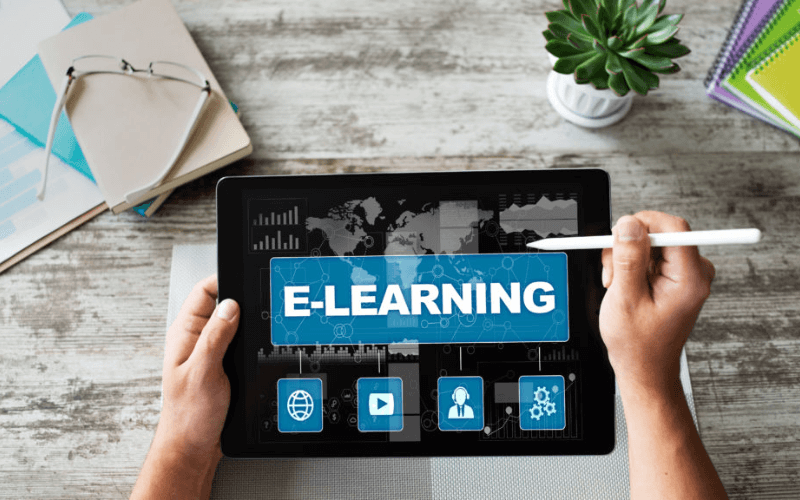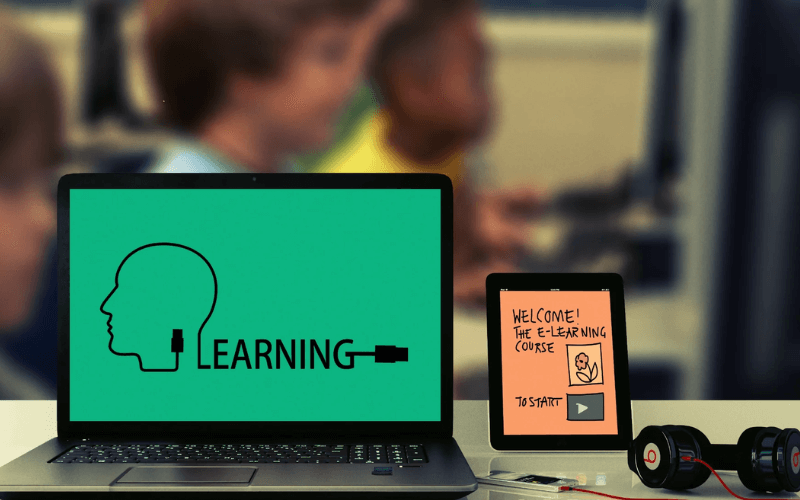Nowadays, people hardly ever
have the time to attend a college or institute to take professional courses. Being
able to study at home has become a necessity. So, what can we do?
The solution is learning via
computers that are connected to the internet and can connect you to a
professional who is skilled at teaching you the material you wish to learn. We
call this concept e-learning. There are many eLearning platforms these
days that offer you e-learning or online classes.

The difficulty of building
E-learning software is widely known to software developers. Each of them
aspires to create six-figure, interesting, and educational learning solutions.
What is an E-learning software?
A business, organization, or
individual can develop online learning experiences and content by using E-learning
software. To some extent, eLearning software is a catch-all word for a wide
range of specialized learning software subcategories.
The increasing popularity of
virtual learning platforms can be attributed to their many benefits.
Because they enable learners
to access courses from anywhere at any time, these platforms offer flexibility.
In addition, they provide
more affordable options in comparison to traditional education, and with online
courses, students may learn at their own pace.
How
does E-learning software work?
The two stages of producing
an online course are creation (also known as authoring) and dissemination.
Course creators have access to a virtual environment using eLearning software.
Platform administrators will
oversee courses, products, and the platform in the administrative environment.
Additionally, the environment is made to give the platform's operational
organization the best possible user and learning management experience.
End users, including
instructors, trainers, students, and learners, interact with the courses and
content as well as with one another in the frontend environment.
A pleasant user experience
for both the person taking the course and the person grading it is the main
goal of the environment's design.
Technologies for developing e-Learning software
Even if you lack extensive
industry experience, creating an eLearning platform is not an
insurmountable task.
Contrary to popular
assumption, building E-learning software doesn't take a lot of time or even
stress you out. To accomplish this, though, the software developers must know a
few exclusive tips and tactics to help them create high-quality e-learning software
without any hassles.
The authoring tools
You may need writing tools
that are appropriate for your team in order to begin developing such a software.
Even with the greatest authoring tools, you risk building an app that users
won't like if your staff doesn't know how to utilize them.
Choose some simple-to-use
tools with pre-built templates and visuals if the developers' abilities don't
match the tools. But, you may also encounter a crew that is well knowledgeable
about the newest technologies available.
Don't be afraid to give them
access to a sophisticated collection of these authoring tools so that you may
satisfy your clients with a better user interface and more functionality.
Additionally, this will make
it much easier for developers to design dynamic software that have all the
features needed for e-learning app.
Content delivery and audience
Prior to doing anything
else, you must recognize your audience's interests and, most significantly, the
linguistic requirements.
It is critical that the
people listening to you comprehend what you are saying. Too much resources will
be wasted on things that are not understood. It would probably be wise to work
with experts who are familiar with the material you want to provide.
Cloud
computing
A collection of computing
resources dispersed around the globe is all that cloud computing is. Cloud
computing ensures that users can access information on any device, from any
location in the world.
Internet of Things (IoT)
IoT is a practical
technology that links instructors and learners globally. Technology facilitates
global communication between e-learners and their teachers.
Artificial
Intelligence
One of the most significant
fields of education is individualized learning, which is made possible by
technology. AI assists students in locating the most appropriate course
material according to their learning style and areas of interest.
Augmented/Virtual Reality
Students are drawn in by the
visual information right away. Additionally, it guarantees the students'
participation, interaction, and learning.
Multimedia
If you don't have the
necessary knowledge or resources to create multimedia elements on your own, you
may easily include links to presentations, movies, and other internet resources
straight into your e-learning course.
As a result, users obtain
knowledge with ease and don't need to look through the entire internet to find
the desired multimedia content.
Because many internet
presentations and videos, including those on YouTube, can be played immediately
within the eLearning course, it also gives the appearance of a more polished
and professional eLearning course.
🔘Read More: Top Programming Languages for Desktop App Development in 2022
Steps
to building Customizable And User-Friendly E-learning Software
An LMS, or e-learning
software solution, might be a perfect solution to all of your problems if you
operate in the e-learning industry.
In the following, we will go
through the steps of building E-learning software.
1.Verify the idea you
have
You must examine the figures
in order to appropriately validate your concept. Based on statistical data, the
global eLearning market is expected to reach a value of $300 billion by 2025.
Developing a product that is
both customizable and user-Friendly is essential for success.
2.Establish a niche
Consider the classes you
plan to teach. Pay attention to the most popular niches, such as those related
to business and entrepreneurship, computers and technology, health and fitness,
personal development, and arts and crafts.
Consider the age, gender,
and educational history of users in addition to their main learning goals and
preferred methods of learning.
3.Select a business plan
Prior to building E-learning
software, the first thing you must decide on is the business plan. This will
dictate how your platform generates revenue for you. Options that you have are:
📅 Purchased credentials
- Customers pay for the service. Users purchase a monthly or annual membership
that grants them unlimited access to the software.
📅 Partner model - Links
to books and other resources that may be required to advance in the course are
included into the courses.
📅 Corporate
collaboration: in order to offer particular courses, you work with commercial
entities.
📅 Paid courses: When users
purchase a paid course, the software owner and the instructor receive the
money.
4.Put in place
essential characteristics
Nearly every eLearning
platform is built around a set of key functionalities. The features of the
admin, teacher, and user panels may generally be separated apart.

Creating an eLearning platform
that only includes the elements that are absolutely necessary is a fantastic
method to test your solution's usability with actual people.
Features of the user profile
include:
-Search, category, and
filter functions allow one to look for particular terms and courses that are
categorized according to subject, cost, level of skill, and other factors.
- Recommendations which
display appropriate training options based on the courses the student has
already enrolled in.
- Simple payment
options which is for quick and safe purchases
Aside from that, each
profile ought to have the user's basic information, past transactions, and
profile settings.
Features of the teacher
profile are:
- The ability to create
and amend courses;
- The ability to be
able to keep track of the courses they have uploaded, the number of individuals
participating, and other information.
Features of the admin profile are:
- User add, edit, and
removal; course add, edit, and removal
- statistical summaries
- control alerts and
modify membership plan
Think about sending out push
and email alerts to subscribers to let them know about upcoming events, new
courses, and other information.
5.Select the development strategy
You have two choices when building
E-learning software: start from scratch or select a pre-made option from the
market. Let's get into further detail about it.
▶️ Development of
customized eLearning platform
Custom solutions are ideal
if you wish to offer particular functionality to a large number of users. It
takes longer, but it allows you to simply scale the platform and add any
features that are needed.
Following the completion of
the eLearning course plan, customized e-learning solutions are developed. At
this point, the software developer can begin writing code and needs to
collaborate closely with the client.
To accomplish their job
effectively, the developers will probably need to provide clarification on a
few client questions. For example, are there any particular prerequisites based
on the scenario that the user wishes to select? Or what occurs when a user
requests the entire course?
Because only one developer
is working on the project, the e-learning software development process may take
longer.

Consequently, hiring a
single e-learning development team is usually a superior choice. You may want
to find out if the team specializes in developing sophisticated e-learning apps
and software, depending on the requirements of the project.
▶️ Ready-made frameworks
for building E-learning software
Open-source programs with
numerous free plugins and basic student management functions include Moodle,
Joomla, and Canvas. Importing bespoke themes or implementing a particular
functionality, however, could be challenging.
Differentiating your
platform from the competition can be achieved by providing a unique design.
Additionally, you must select the best tech stack for your requirements.
In terms of UX and UI,
minimalism is essential. The e-learning website must to be simple to use and
intuitive.
Furthermore, since we always
carry mobile devices with us, the learning platform ought to have a responsive
design. In addition to using the appropriate technology, you can create an
interesting user experience by utilizing third-party tools or external plug-ins.
🔘 Related: Understanding Operating Systems for Effective Programming
Conclusion
Electronic learning, or
e-learning, is the term for instruction provided by digital devices including
laptops, tablets, and smartphones. Users can learn at their own pace and
without having to physically attend a typical classroom thanks to this
technology.
Numerous industries have
been severely damaged by the COVID-19 pandemic. While some of them completely
stagnated, others thrived. One of the few that has grown is e-learning, which
enables people to improve themselves during difficult circumstances.
With e-Learning turning
become a need for our working lives, the market is flooded with technologies
that we may use.
With these resources and the
understanding of building E-learning software, one may effortlessly give his or
her clients the training they need to achieve their goals.
If you are on the path of
creating an eLearning platform, contact us now to get the help you need.